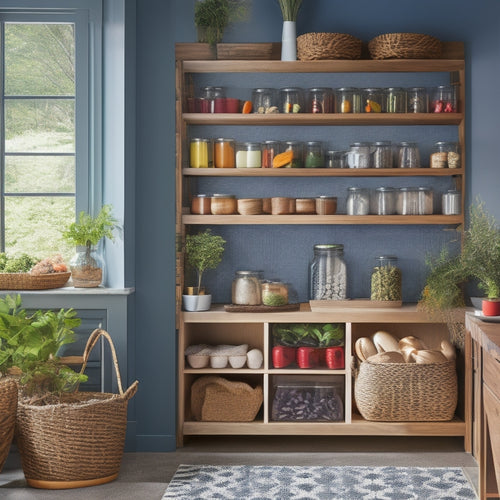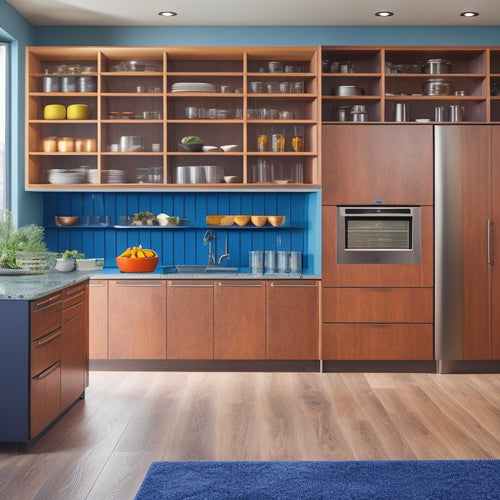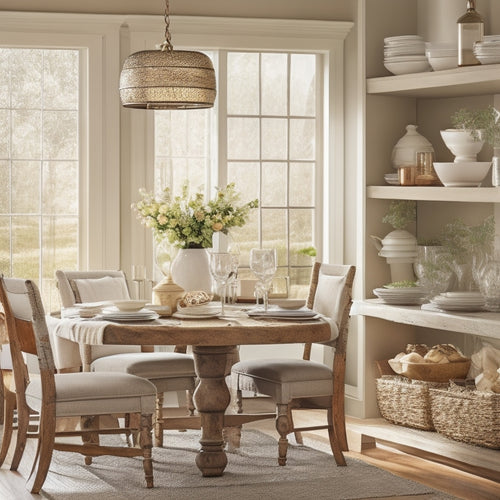
Optimize Your Kitchen for Clean Eating Success
Share
You're on a mission to optimize your kitchen for clean eating success, and it starts with strategic storage. Stock your kitchen with whole, nutrient-dense foods, and consider gluten-free, vegan, or allergy-friendly options. Implement a clear labeling system to prevent cross-contamination and make meal prep a breeze. Maximize vertical space with shelving and baskets, and utilize hanging hooks for pots, pans, and utensils. By decluttering and organizing your pantry staples, you'll be able to focus on mindful meal prep and cook healthy meals efficiently. Now, take the next step towards a clean eating environment that fuels your well-being.
Key Takeaways
• Organize your kitchen with a functional layout, categorizing utensils and grouping similar items together for easy identification and access.
• Implement a color-coded labeling system to distinguish between different dietary categories, preventing cross-contamination and promoting mindful meal prep.
• Maximize vertical space with shelving and storage baskets, and utilize hanging hooks for pots, pans, and utensils to optimize kitchen workflow.
• Designate specific zones for ingredient storage, prep, and cooking, and implement a smart labeling system to identify healthy options easily.
• Maintain a clean eating environment by decluttering, minimizing food waste, and promoting healthier eating habits with a minimalist approach.
Kitchen Storage for Special Dietary Needs
As you stock your kitchen with whole, nutrient-dense foods, you'll need to think about how to store them in a way that accommodates your specific dietary needs, whether that means gluten-free, vegan, or allergy-friendly options. This is especially vital when managing dietary restrictions, as cross-contamination or mistaken consumption can have serious consequences.
Implementing a clear labeling system is key to ensuring your kitchen storage is safe and organized. Consider using color-coded labels or stickers to distinguish between different dietary categories. For instance, you might use green labels for vegan options, red for gluten-free, and yellow for nut-free products. This visual system will help you quickly identify which foods are safe for you to consume.
Additionally, consider storing similar items together, such as all gluten-free grains in one cabinet or all vegan snacks in another. By creating a thoughtful storage system, you'll be able to maintain a sense of control and confidence in your kitchen, even with complex dietary restrictions.
Maximizing Vertical Space Efficiently
You'll be surprised at how much more storage capacity you can squeeze out of your kitchen by maximizing its vertical space efficiently. By installing vertical shelving, you can double or even triple your storage capacity, keeping frequently used items within easy reach.
Consider adding storage baskets or bins to store dry goods, spices, or cooking utensils, keeping them organized and out of the way.
Take advantage of the often-wasted space on your walls and ceilings by using hanging hooks to store pots, pans, utensils, or even kitchen towels. This won't only free up cabinet space but also add a touch of industrial chic to your kitchen.
Speaking of cabinets, don't forget to optimize their interior space with cabinet organizers, such as shelves, dividers, or lazy susans. These will help you make the most of the space you have, keeping your kitchen essentials organized and easily accessible.
Decluttering for Mindful Meal Prep
As you start meal prepping, you'll quickly realize that cluttered countertops can be a major obstacle.
By clearing the clutter, you'll free up valuable space to focus on preparing healthy meals.
Let's get started by tackling the first point: clearing the clutter and freeing up those countertops.
Clear the Clutter
Get ready to breathe a sigh of relief as you tackle the overwhelming task of clearing out your kitchen clutter and discover how a tidy space can transform your meal prep experience.
A clutter-free kitchen is essential for mindful meal prep, and it all starts with adopting a minimalist approach. Begin by purging items you no longer need or use, and organize the remaining essentials in a functional layout that makes sense for your cooking style.
Implementing simple organization tips, such as categorizing utensils and grouping similar items together, will make a significant difference in your kitchen's overall flow. Focus on keeping only the essential items that bring you joy and serve a purpose, and consider storing less frequently used items in designated areas, like a pantry or cabinets.
Free Up Countertops
Six key countertop zones - food prep, cooking, storage, cleaning, entertaining, and trash management - are waiting to be freed from clutter and optimized for mindful meal prep.
To free up your countertops, you'll need to rethink how you use your space. Start by designating specific areas for each zone, and then purge any unnecessary items that are taking up valuable real estate.
Here are three essential steps to help you achieve a clutter-free countertop:
-
Install wall mounted shelves to maximize vertical storage and keep frequently used items within easy reach.
-
Incorporate hidden storage solutions, such as cabinets or drawers, to stash away infrequently used appliances and kitchen gadgets.
-
Opt for minimalistic decor that serves a functional purpose, like a utensil holder or spice rack, to maintain a sense of calm and focus.
Smart Labeling for Easy Identification
By assigning a designated spot for each food group and labeling them accordingly, you can create a visual system that helps you quickly identify the healthy options in your kitchen. This smart labeling strategy makes it easy to find what you need, reducing the temptation to grab unhealthy alternatives.
Implement a color-coded organization system, where similar food groups are categorized by color. For instance, label your fruits and vegetables with green stickers, whole grains with yellow, and lean proteins with blue. This visual cue will help you navigate your kitchen with ease.
Quick reference labels can also be used to provide additional information, such as cooking instructions or nutritional facts. You can place these labels on storage containers, shelves, or even the fridge. Having this information readily available saves you time and guarantees you're making informed choices.
Customizing Your Kitchen Workflow
As you continue to optimize your kitchen for clean eating success, it's time to focus on customizing your kitchen workflow to make meal prep a breeze.
By assigning specific zones within your kitchen and streamlining your food prep process, you'll be able to cook healthy meals more efficiently and effectively.
Kitchen Zone Assignments
Within your kitchen, assigning specific zones for different tasks helps streamline your workflow, allowing you to prep, cook, and clean more efficiently. By designating specific areas for certain tasks, you'll reduce clutter, increase productivity, and minimize the risk of cross-contamination.
This task delegation approach enables you to focus on each step of the cooking process without distractions.
Here are three key zones to ponder:
-
Ingredient Storage Zone: Designate a specific area for storing ingredients, taking into account dietary restrictions and allergies. Label and organize your storage containers to ensure easy access to the ingredients you need.
-
Prep Zone: Assign a zone for food preparation, including chopping, dicing, and marinating. This area should be equipped with necessary tools and utensils, such as cutting boards, knives, and bowls.
-
Cooking Zone: Identify a zone for cooking, including your stove, oven, or cooktop. Ensure this area is well-ventilated and equipped with necessary cookware and utensils.
Streamlined Food Prep
With your kitchen zones assigned, you can now focus on customizing your workflow to maximize efficiency and minimize food prep time. This is where the magic happens, and you'll be amazed at how much time you can save with a few simple tweaks.
Start by identifying the tasks that take up the most time in your kitchen, such as chopping vegetables or cooking proteins. Then, implement time-saving techniques like prep-ahead stations, where you can chop and prep ingredients in advance, or invest in space-saving solutions like an Instant Pot or air fryer that can cook food quickly and efficiently.
Next, consider your meal prep strategies. Do you find yourself cooking the same meals every week? Create a meal prep plan that allows you to cook in bulk and refrigerate or freeze for later. This won't only save you time but also reduce food waste.
Purge and Organize Pantry Staples
You'll be surprised at how a simple pantry purge can transform your cooking habits and set you up for clean eating success. By getting rid of expired, processed, and unhealthy foods, you'll make room for fresh, whole ingredients that will enhance your meals.
Here's how to do it:
-
Check expiration dates and discard anything that's past its prime. This guarantees you're not consuming spoiled or contaminated foods that can compromise your health.
-
Implement ingredient rotation by storing new items behind existing ones, so you use the oldest items first.
-
Categorize by food group and label accordingly. This involves grouping similar items together, such as grains, canned goods, and baking supplies. Label each category so you can easily find what you need.
Frequently Asked Questions
Can I Optimize My Kitchen on a Limited Budget?
You can definitely optimize your kitchen on a limited budget! Look for budget-friendly solutions like repurposing items, creative space-saving ideas, and affordable organization tools. DIY storage solutions can also help maximize your space without breaking the bank.
How Do I Maintain My Kitchen Organization Over Time?
Imagine your kitchen staying organized and clutter-free, like a serene oasis, forever! To achieve this, you'll need to master time management and create sustainable habits, like scheduling weekly tidying sessions and assigning tasks to each family member.
Are There Any Kitchen Organization Tools for Renters?
As a renter, you'll love these storage solutions and space-saving ideas that are temporary fixes and rental-friendly options, ensuring your kitchen stays organized without damaging the space or violating your lease.
Can I Involve My Family in the Kitchen Organization Process?
You're like a conductor leading an orchestra, and getting your family involved in kitchen organization is like harmonizing the instruments. Assign tasks to create a team, making your kitchen setup a symphony of efficiency, and watch your family bond over a clutter-free space!
How Often Should I Reassess My Kitchen Organization System?
You should reassess your kitchen organization system regularly, ideally every 3-6 months, to verify it's still working for you and identify areas for improvement, incorporating new efficiency tips to maintain a safe and functional space.
Related Posts
-

Sliding Pantry Storage Ideas for Renters
If you're looking to optimize your rental kitchen, sliding pantry storage solutions could be your answer. Employ vert...
-

Roll-Out Trays for Modular Kitchen Cabinets
Roll-out trays are the perfect addition to your modular kitchen cabinets, enhancing both accessibility and organizati...
-

Corner Cabinet Storage for Dinnerware Sets
Corner cabinet storage for dinnerware sets can change your kitchen into an organized, stylish space. By utilizing ver...


